4- A charged ball of mass (1.5 g) is suspended on a light string in the presence of a uniform external electric field, as shown in figure. At equilibrium the angle of the string with the vertical (0 = 35°) and the tension in the string is (0.004 N). If the charge of the ball equals (5 µC), find the magnitude and direction of the electric field intensity. %3D (Ans. E=2330 N/C with angle 78.7° with x-axis)
4- A charged ball of mass (1.5 g) is suspended on a light string in the presence of a uniform external electric field, as shown in figure. At equilibrium the angle of the string with the vertical (0 = 35°) and the tension in the string is (0.004 N). If the charge of the ball equals (5 µC), find the magnitude and direction of the electric field intensity. %3D (Ans. E=2330 N/C with angle 78.7° with x-axis)
Principles of Physics: A Calculus-Based Text
5th Edition
ISBN:9781133104261
Author:Raymond A. Serway, John W. Jewett
Publisher:Raymond A. Serway, John W. Jewett
Chapter20: Electric Potential And Capacitance
Section: Chapter Questions
Problem 19P: Two particles, with charges of 20.0 nC and 20.0 nC, are placed at the points with coordinates (0,...
Related questions
Question
100%

Transcribed Image Text:4- A charged ball of mass (1.5 g) is suspended on a light string in the presence of a uniform
external electric field, as shown in figure. At equilibrium the angle of the string with the
vertical (0 = 35°) and the tension in the string is (0.004 N). If the charge of the ball equals
(5 µC), find the magnitude and direction of the electric field intensity.
(Ans. E=2330 N/C with angle 78.7° with x-axis)
///
E

Transcribed Image Text:Question 5
Two particles, with charges of 20 nC and -20 nC, are placed at the points with
coordinates (0, 4 cm) and (0, -4 cm) as shown in Figure 4. A particle with charge 10 nC is
located at the origin.
(a). Find the electric potential energy of the configuration of the three fixed charges.
(b). A fourth particle, with a mass of 2 x 10-13 kg and a charge of 40 nC, is released from
rest at the point (3 cm, 0). Find its speed after it has moved freely to a very large
distance away.
20.0 nC
4.00 cm
10.0 nC
3.00 cm
40.0 nC
4.00 cm
-20.0 nC
Figure 4.
Expert Solution
This question has been solved!
Explore an expertly crafted, step-by-step solution for a thorough understanding of key concepts.
Step by step
Solved in 3 steps with 2 images

Knowledge Booster
Learn more about
Need a deep-dive on the concept behind this application? Look no further. Learn more about this topic, physics and related others by exploring similar questions and additional content below.Recommended textbooks for you

Principles of Physics: A Calculus-Based Text
Physics
ISBN:
9781133104261
Author:
Raymond A. Serway, John W. Jewett
Publisher:
Cengage Learning

Physics for Scientists and Engineers, Technology …
Physics
ISBN:
9781305116399
Author:
Raymond A. Serway, John W. Jewett
Publisher:
Cengage Learning

Physics for Scientists and Engineers with Modern …
Physics
ISBN:
9781337553292
Author:
Raymond A. Serway, John W. Jewett
Publisher:
Cengage Learning

Principles of Physics: A Calculus-Based Text
Physics
ISBN:
9781133104261
Author:
Raymond A. Serway, John W. Jewett
Publisher:
Cengage Learning

Physics for Scientists and Engineers, Technology …
Physics
ISBN:
9781305116399
Author:
Raymond A. Serway, John W. Jewett
Publisher:
Cengage Learning

Physics for Scientists and Engineers with Modern …
Physics
ISBN:
9781337553292
Author:
Raymond A. Serway, John W. Jewett
Publisher:
Cengage Learning

Physics for Scientists and Engineers
Physics
ISBN:
9781337553278
Author:
Raymond A. Serway, John W. Jewett
Publisher:
Cengage Learning

College Physics
Physics
ISBN:
9781285737027
Author:
Raymond A. Serway, Chris Vuille
Publisher:
Cengage Learning

College Physics
Physics
ISBN:
9781305952300
Author:
Raymond A. Serway, Chris Vuille
Publisher:
Cengage Learning